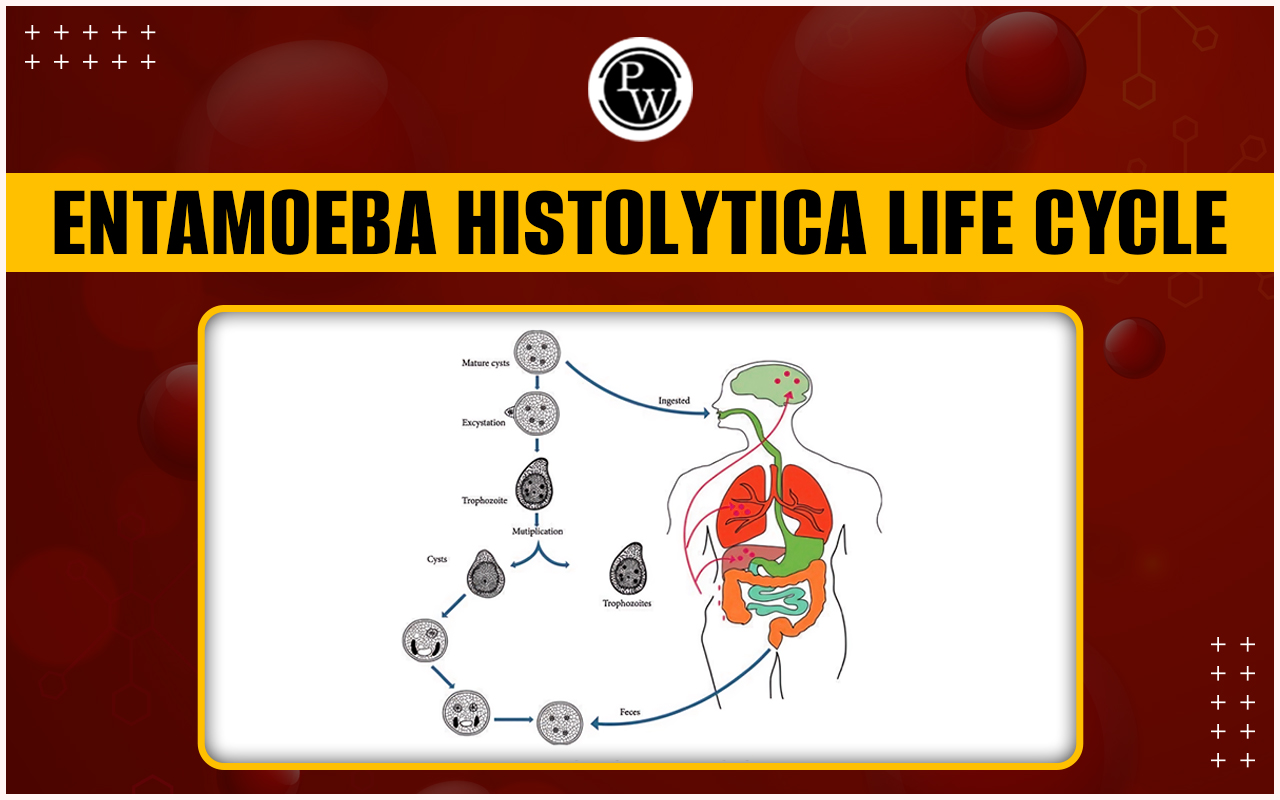

Can you imagine an organism inside our body? Have you heard about Entamoeba histolytica, where it lives, and how it spreads? Is it harmful to humans or not? This article will help you explore Entamoeba histolytica, its life cycle, and how it spreads and harms humans. We will briefly explain Entamoeba histolytica before going over its life cycle. Then how it spreads and affects humans?
This article aims to explain Entamoeba histolytica, its life cycle, and how it spreads and affects humans.Introduction
Entamoeba histolytica, a tiny parasitic protozoan, feeds on the colon's red blood cells, mucosa, and submucosa. Entamoeba histolytica is a member of the order Lobosa, class Sarcodina, and phylum Protozoa. This single-celled organism causes ulcers, amoebiasis, and liver abscesses. It is especially prevalent in areas with inadequate sanitation and spread by faeces contaminating food and water. It invades the mucosa and submucosa layers of the human large intestine to induce amoebic dysentery. It can enter the lungs, liver, brain and other organs and the large intestine. Countries with tropical and subtropical climates frequently host Entamoeba histolytica.Entamoeba Histolytica Life Cycle
During its life cycle, Entamoeba histolytica goes through two main stages: 1. Cyst Stage: Entamoeba histolytica's life cycle begins when a mature cyst ingested through faeces-contaminated food, water, or oral-anal sex activity. Once ingested, the cyst resists desiccation, gastric acidity, and chlorination. It can survive for several weeks in moist environments. The cyst travels from the mouth to the small intestine, where excystation occurs. The cyst divides into eight trophozoites during excystation through nuclear, followed by cytoplasmic division. These trophozoites subsequently go to the large intestine.Double Fertilization In Angiosperms
2. Trophozoite Stage: Trophozoites reproduce through binary fission that passes through human faeces. A self-limiting and asymptomatic infection is frequently the result of the freshly produced trophozoites aggregating in the intestinal mucin layer and creating new cysts. Trophozoites may also colonise the commensal flora in the intestinal lumen. Numerous trophozoites are still present in the small intestinal lumen. The remaining ones adhere to the intestinal mucosa, travel into the bloodstream, and then spread throughout the host's lungs, liver, brain and other organs. 3. Pathogenesis The parasites express numerous virulence factors, such as lectin, lytic peptide, cysteine, proteinases, and phospholipase. Eight trophozoites release following the excystation of an intestinal cyst, and they colonise the large intestine. In pathogenesis, the binding of trophozoites with the colonic epithelium is a dynamic process. After adhesion, trophozoites lyse the target cell using a protein resembling an ionophore, resulting in ion leaking from the cytoplasm. Intestinal amoebiasis is characterised by tissue degradation caused by the entamoeba's proteolytic enzymes, resulting in flask-shaped amoebic ulcers. Through blood circulation, parasites from the colon may transport to other crucial organs like the liver, heart, brain, etc.Related Links -
Clinical Manifestation
- Acute intestinal amebiasis dysentery (i.e. bloody, mucus-containing diarrhoea)
- Flatulence and lower stomach discomfort.
- Low-grade symptoms of chronic amebiasis include sporadic diarrhoea, weight loss, and weariness.
- About 90% of infected people are asymptomatic, yet they could still be carriers. In some people, the cecal or rectosigmoid regions of the colon may develop an ameboma, a granulomatous disease. Lesions are recognised from colon adenocarcinomas since they resemble them.
- The presence of trophozoites in diarrhoeic stools or cysts in formed stools is required to diagnose intestinal amebiasis. After collecting diarrheal faeces, they are tested an hour later to evaluate the trophozoite's ameboid motility. The trophozoite typically contains red blood cells.
Related Links -
Entamoeba Histolytica Life Cycle <span style=
During excystation, the cyst divides into how many trophozoites?
The cyst divides into eight trophozoites during excystation.
How many main stages are there in the life cycle of Entamoeba histolytica? Name them
There are two main stages in the life cycle of Entamoeba histolytica: the cyst and trophozoite.
Where does the excystation of cysts occur in the human body?
The cysts' excystation occurs in the human body's small intestine.
Which process is involved in the multiplication of trophozoites?
Multiplication of trophozoites occurs through binary fission.
What food consumes Entamoeba histolytica?
Entamoeba histolytica feeds on the colon's red blood cells, mucosa, and submucosa.
Entamoeba histolytica: How to avoid it?
The parasitic invasion can be prevented if dwellings are kept cleaner. This parasite can be avoided by thoroughly cleaning fruits and vegetables before use. Avoid sexual contact if infected.
What is Amebiasis?
Entamoeba histolytica, a tiny parasitic protozoan, causes an intestinal infection known as Amebiasis.
🔥 Trending Blogs
Talk to a counsellorHave doubts? Our support team will be happy to assist you!

Free Learning Resources
PW Books
Notes (Class 10-12)
PW Study Materials
Notes (Class 6-9)
Ncert Solutions
Govt Exams
Class 6th to 12th Online Courses
Govt Job Exams Courses
UPSC Coaching
Defence Exam Coaching
Gate Exam Coaching
Other Exams
Know about Physics Wallah
Physics Wallah is an Indian edtech platform that provides accessible & comprehensive learning experiences to students from Class 6th to postgraduate level. We also provide extensive NCERT solutions, sample paper, NEET, JEE Mains, BITSAT previous year papers & more such resources to students. Physics Wallah also caters to over 3.5 million registered students and over 78 lakh+ Youtube subscribers with 4.8 rating on its app.
We Stand Out because
We provide students with intensive courses with India’s qualified & experienced faculties & mentors. PW strives to make the learning experience comprehensive and accessible for students of all sections of society. We believe in empowering every single student who couldn't dream of a good career in engineering and medical field earlier.
Our Key Focus Areas
Physics Wallah's main focus is to make the learning experience as economical as possible for all students. With our affordable courses like Lakshya, Udaan and Arjuna and many others, we have been able to provide a platform for lakhs of aspirants. From providing Chemistry, Maths, Physics formula to giving e-books of eminent authors like RD Sharma, RS Aggarwal and Lakhmir Singh, PW focuses on every single student's need for preparation.
What Makes Us Different
Physics Wallah strives to develop a comprehensive pedagogical structure for students, where they get a state-of-the-art learning experience with study material and resources. Apart from catering students preparing for JEE Mains and NEET, PW also provides study material for each state board like Uttar Pradesh, Bihar, and others
Copyright © 2025 Physicswallah Limited All rights reserved.
Get App











